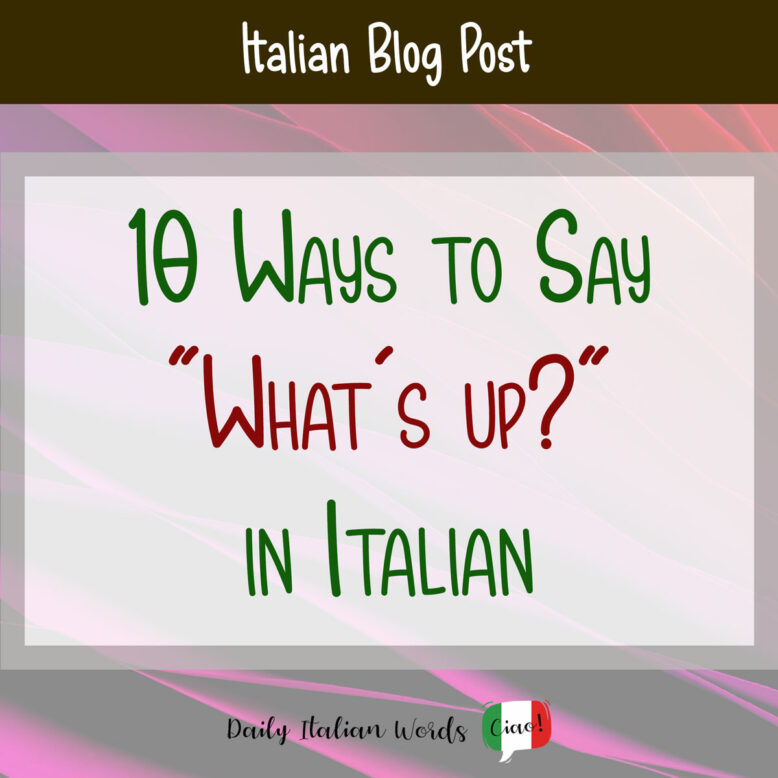Ever felt the itch to chat in Italian but got stuck figuring out how to kick things off? Well, knowing how to say “What’s up?” in Italian is an incredibly handy skill that can open the door to casual exchanges. Seriously, it’s amazing to think how often this simple phrase can help you spark some interesting conversations!
So, ready to break the ice Italian-style? Below, I’ll share 10 lively ways to greet others with “What’s up?” in Italian. Whether you’re chatting with friends or mingling at a more formal gathering, these expressions will help you sound natural and confident when greeting people.

1. Come va?
Come va? is the most common way to say What’s up? in Italian, perfect for any casual encounter. It literally means How does it go?, with va being the third person singular of the verb andare (to go), giving the verb an impersonal vibe that makes it super versatile. You can use it in any social setting since it’s neutral in formality and gender. Whether you’re talking to one person or a whole crew, it keeps things simple:
Ciao ragazzi, come va?
Hi guys, what’s up?
In Italian, it’s also very common to use this expression conjugated at the first person plural, like Come andiamo? (How are we doing?), maintaining its friendly and generic tone:
Andrea, carissimo! Come andiamo?
Andrea, dear, what’s up?
To show a bit more warmth or curiosity, try asking Come va la vita? (How’s life?) or Come vanno le cose? (How are things going?), great for catching up after a while and showing genuine interest:
Che bello rivederti, Anna! Allora, come va la vita?
How nice to see you again, Anna! So, how’s life?

2. Come stai? / Come sta?
This is the classic How are you?, perfect for friends and acquaintances alike. These questions offer a more direct and personal way to connect compared to the generic Come va? They use the verb stare (literally “to stay”), adjusted based on who you’re addressing. Come stai? is informal, used with friends and family, while Come sta? is formal and respectful, suitable for elders, acquaintances, or anyone you wish to show respect to.
Ciao Michele! È da un pò che non ci sentiamo, come stai?
Hi Michele! It’s been a while since we talked, how are you?
Dottor Rossi, come sta? Ho sentito che è in partenza!
Doctor Rossi, how are you? I heard you’re leaving!
Depending on the context, Come stai? / Come sta? can also inquire about one’s well-being with the meaning How do you feel?:
Come stai, Chiara? Ti fa ancora male la testa?
How do you feel, Chiara? Does your head still hurt?

3. Com’è?
Com’è? is the short, snappy, and super casual version of Come va, a slang expression particularly popular in certain regions of northern Italy. So be cautious: using it in other parts of the country might raise eyebrows – and questions like Com’è cosa? – How is what? So, choose your moments wisely!
Ciao, com’è?
Hey, what’s up?
You can also add allora (so) before the question to ease into the chat with a friendly nudge:
Ciao Andrea! Allora, com’è?
Hey Andrea! So, what’s up?

4. Che si dice?
Literally translated to What’s being said?, Che si dice? is a casual way of asking What’s up? in Italian. It’s pretty informal and can be used to inquire about what’s happening with someone or more broadly about current events. Imagine you’re giving a friend in Milan a call and you’re eager to catch up on his life in the city. You might ask:
Che si dice lì a Milano?
What’s up in Milan?

5. Cosa mi racconti? / Cosa mi racconta?
When you want to ask What’s up? in Italian and truly get to know how someone is doing, you can use Cosa mi racconti? This informal phrase revolves around the verb raccontare (to tell, to recount) and is often paired with allora (so):
Stefania! Allora, cosa mi racconti? Come va la scuola?
Stefania! What’s up? How’s school going?
For a more courteous approach, you can use the polite form Cosa mi racconta? This version is particularly fitting when conversing with older individuals whom you know well and wish to address respectfully:
Signor Luigi, cosa mi racconta? Come stanno le sue nipotine?
Mr Luigi, what’s new? How are your granddaughters doing?

6. Novità?
Now, here’s a phrase that’s close to my heart – Novità? It literally means Any news? and it’s something my grandmother always asks whenever I visit her. It’s her way of saying, Tell me everything that’s new and exciting in your life! This expression is perfect for those moments when you want to catch up with friends or family and you’re eager to hear about their latest updates:
Elena, tesoro, novità?
Elena, darling, any news?
If you’re not in the mood to share your life’s details, you can simply respond with Niente di nuovo (Nothing new). It’s a polite way to say that there’s nothing noteworthy to report.

7. Come butta?
Come butta? is pure youth slang for checking in with friends in the most laid-back way possible. It’s built around the third person singular of the verb buttare (to throw) and literally translates to How’s it throwing? It might sound odd in English, I know, but it’s like saying What’s up? with that extra chill vibe.
Bella raga, come butta?
Hey guys, what’s up?
Some interesting things to note in this example: Bella isn’t about beauty, it’s a slangy way of saying ciao, and raga is shorthand for ragazzi (guys). Put them together, and bella raga is how Italian teens kick off conversations with their group of friends!

8. Tutto bene? / Tutto ok?
These phrases, meaning Everything good? or All well?, go beyond casual conversation starters; they are genuine ways to check in and show you care about someone’s well-being. Imagine noticing your friend has been unusually quiet lately – you might nudge him gently and say:
Hey Luca, tutto bene? Come va il nuovo lavoro?
Hey Luca, everything good? How’s the new job going?
Notice how this question isn’t just a simple What’s up? in Italian; it’s a way to show Luca that you’re there and maybe it can even spark a conversation about his new job.

9. Tutto a posto?
A similar expression is Tutto a posto?, which literally translates to Everything in place? – a bit like asking, Is everything where it should be in your world? Again, it shows you care, whether offering assistance to a friend who seems down or extending help to a stranger who appears a bit lost:
Ciao Carlo, tutto a posto?
Hello Carlo, is everything ok?
Signora, tutto a posto? Ha bisogno di aiuto?
Is everything ok, madam? Do you need help?

10. Che succede?
Che succede? (literally, What happens?) is your go-to phrase when you want to know if something’s wrong or if someone needs a shoulder to lean on. It’s a question that works well in all contexts, whether it’s checking in with friends, comforting upset children, or approaching a stranger with a friendly face:
Che succede, Ilaria? Chi ti ha fatto arrabbiare?
What’s up, Ilaria? Who upset you?

Valentina Nicastro is a travel writer in love with her home country, Italy. Having travelled widely around the globe, she realised there was more to explore closer to home and decided to put the passport aside for a while. When she is not immersed in documenting Italy, you’ll find her donning her communication consultant hat, weaving words as a content writer and bridging linguistic divides as a translator.


